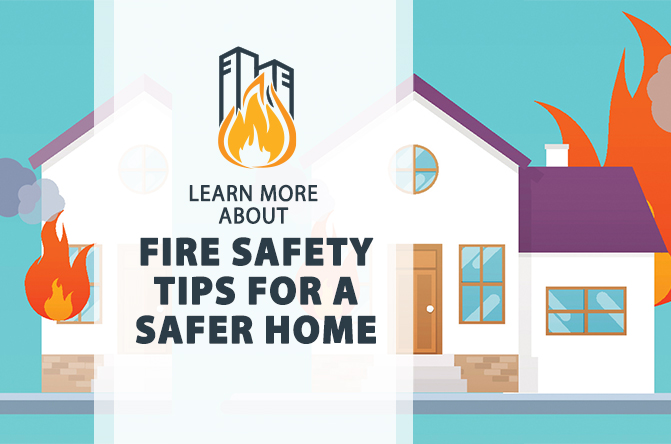Written by Andy Gurczak
June 11, 2021

Learn the Top Fire Safety Tips
How Can I Prevent Home Fires?
Losing your home to a fire is a scary thought, but there’s plenty you can do to prevent them. The following article explores the most successful fire safety tips to keep your home safe from electrical, grease, chemical and other types of house fires.
Kitchen fires and heating are the leading causes of home fires and fire injuries. Additionally, the winter months are the peak time for fires and fire-related deaths. It is extremely important to review fire safety tips and take action now.
Things to Know About Fires
- First, know that fire is fast. In less than 30 seconds a small flame can turn into a major fire. In like manner, it only takes a few minutes for thick black smoke to fill a house or for flames to engulf a structure.
- Secondly, the heat produced by the fire can be more threatening than flames itself. At floor level, room temperatures can rise up to 100 degrees. Meanwhile, they can escalate up to 600 degrees at eye level. Breathing in this super-hot air will scorch your lungs and melt clothes to your skin.
- Third, fire starts bright, but quickly produces black smoke that can produce complete darkness.
- Fourthly, smoke and toxic gases kill more people than flames do. Fire produces poisonous gases that make you disoriented and drowsy. Suffocation is the leading cause of fire deaths, exceeding burns by a 3-to-1 ratio.
Before a Fire
Create and Practice a Fire Escape Plan
Good habits can prevent fires. Nonetheless, you should have a plan in case of emergencies. Discuss with your family what to do if a fire starts while you’re home.
In the event of a fire, remember that every second counts. Escape plans help you get out of your home quickly. For this reason, you should practice your home fire escape plan at least twice a year. The following are some fire safety tips to consider when preparing this plan:
- First and foremost, make sure you have two exits out of each room in the event the primary way is blocked.
You must also make sure that windows are not stuck. Additionally verify that screens can be taken out quickly and that security bars can be properly opened. - Also important is to practice feeling your way out of the house in the dark or with your eyes closed.
- Teach children not to hide from firefighters.
- Time your escape plan.
- Choose two meeting places away from your house in case of separation.
- Furthermore, show everyone in your home where to find the gas and power shut offs.
- Equally important, is to make sure children have a way to contact you. Also have kids know information like your address and phone number.
- Teach kids to STOP, DROP, and ROLL and how to call 911 in an emergency
- Keep equipment like fire escape ladders (in upstairs bedrooms) and fire extinguishers ready if you even need them. Fire-safe emergency kits are also helpful in scenarios like this.
Smoke Alarms
An extremely important fire safety tip to consider is to have working smoke alarms These significantly increase your chances of surviving a deadly home fire.
- When dealing with smoke alarms, make sure you replace batteries twice a year. This is unless you are using 10-year lithium batteries.
- Install smoke alarms on every level of your home, including the basement.
- Smoke alarm system replacement is advised every 10 years but this may vary from brand to brand.
- Disabling a smoke alarm can be a deadly mistake. NEVER disable alarms.
Smoke Alarm Safety for People with Access or Functional Needs
- Audible alarms for visually impaired people should pause with a small window of silence between each successive cycle.
- This is so that they can listen to the instructions or voices of others.
- Know that smoke alarms with a vibrating pad or flashing light are available for the hearing impaired.
- In fact, there are even smoke alarms with a strobe light. These are ideal for outside the home to catch the attention of neighbors or passerbys and get them to call for help.
Measure carbon monoxide levels
Carbon monoxide doesn’t damage your home like a fire does, but it’s still seriously dangerous. Carbon monoxide is an odorless, colorless gas released from burning carbon materials like fuel.
Burning wood, natural gas, coal, gasoline, and heating oil can all release CO into your home. When you cook on your gas stove or use your fireplace improperly, you increase the risk of fire and carbon monoxide poisoning in your home. Preventing carbon monoxide accidents is an important fire safety tip:
- First and most importantly, install carbon monoxide alarms
- Consider getting an alarm that has remote access through an app so you can be alerted even if you’re away from home.
- Know that a carbon monoxide alarm won’t give out false alarms from steam or smoke.
- Consider getting a dual sensor carbon monoxide and smoke detector that senses heat, smoke, and CO. This will cut down installation time and costs and can potentially save your life.
Additional Fire Safety Tips for Before Fires
- Make digital copies of valuable documents and records like birth certificates.
- When sleeping, keep the bedroom door closed.
- Keep a fire extinguisher in your home. Educate yourself on the proper use and maintenance of them.
- Installing an automatic fire sprinkler system in your residence is also a pretty good call.
During a Fire
There are a few fire safety tips you must know that could save your life during a fire:
- First of all, know that you must crawl low under any smoke to your exit. Heavy smoke and poisonous gases collect first along the ceiling.
- Before opening a door, feel the doorknob and door. If it’s hot or there is smoke coming around the door, leave the door closed. Without delay, look and use your second way out.
- Open doors slowly. Shut it as quickly as possible if heavy smoke or fire is present.
- If you can’t get to someone needing assistance, leave the home and call 911 or the fire department. Tell the emergency operator where the person is located.
- Tell firefighters immediately if pets are trapped inside your home
- If you can’t get out, close the door and cover vents and cracks around doors. Call 911 or your fire department right away.
- Tell them where you are and signal for help at the window with a light-colored cloth or a flashlight.
- Remember to STOP, DROP, and ROLL: If your clothes catch fire, stop immediately, drop to the ground, and cover your face with your hands. Then, roll back and forth until the fire is out. If you cannot stop, drop, and roll, smother the flames with a blanket or towel.
- Use cool water to treat burns ASAP. Wash for three to five minutes, cover with a clean, dry cloth and get medical help right away.
Fire Escape Planning for Older Adults and People with Access or Functional Needs
- If you use a walker or wheelchair, check all exits to be sure you get through the doorways.
- Provide exit ramps and widen doorways. Make any necessary accommodations to facilitate an emergency escape.
- Create a fire escape plan and speak to your family members, building manager or neighbors about it. It is extremely important that you practice it with them.
- Contact your local fire department’s non-emergency line and ask emergency providers to keep your special needs information on file.
- Keep a phone near your bed.
Fire Safety Tips for After The Disaster
- First, if you are insured, contact your insurance company as soon as possible. Ask for detailed instructions on protecting your property, conducting inventory and contacting fire damage restoration companies.
- If you aren’t insured, or even if you are,you can contact your local disaster relief service, such as The Red Cross. They can help if you need temporary housing, food and medicines.
- Receive confirmation from the fire department that your residence is safe to enter.
- The fire department should make sure that utilities are either safe to use or are disconnected before they leave the site. DO NOT reconnect utilities yourself.
- Conduct an inventory of damaged property and items. Do not throw away anything until an inventory is made.
- Save receipts for any money you spend related to fire loss. The insurance company may need receipts verifying losses claimed on your income tax.
- Notify your mortgage company of the fire.
Fire Safety Tips for Every Section of the Home
In the kitchen
Kitchens are the part of the house that deserve the most attention because of all the heat and fire handled there, besides the appliances that reside there
When cooking, be sure your oven, stove, and any hot plates are far away from flammable items like curtains, rags, or chemicals.If you can help it, don’t leave the room unattended. Turn off heat if you do. Additionally, wear short, close-fitting or tightly rolled sleeves when cooking. Above all, keep a fire extinguishers in the kitchen in case of grease fires or other emergencies.
How to Put Out a Grease Fire
- First, try not to panic, just handle it as soon as you can.
- Secondly, cover the fire with a heavy metal lid and turn off the heat source.
- Thirdly, you can use baking soda or salt to handle a small fire. DO NOT use water to put out the fire. Since water and oil don’t mix, pouring water can cause the oil to splash and spread the fire.
- Fourthly, keep a B-Class dry chemical fire extinguisher around in case the fire grows.
Call 911 if you can’t extinguish the fire, and GET OUT.
Fire Safety Tips for Sleeping areas
Good habits and smart fire safety practices can help prevent fires in the bedroom too:
Start by taking a look at your mattress to make sure it contains flame-retardant chemicals inside. For extra protection, consider a flame-retardant mattress cover.
Electric blankets, smoking in bed, space heaters, and overloaded wall sockets are all hazards in the bedroom. If you smoke, take it outside. Only use electric blankets with automatic shut off abilities. And avoid overloading wall sockets and power strips with too many plugs.
Fire Safety Tips for the Living Room
Having a fireplace in your living room or den may be a hot spot for fire hazards. Remember to keep the fireplace clean and clear of debris or flammable items even when not in use. Having a Christmas tree near the fire can be seriously dangerous if you don’t take precautions.
When using your fireplace, keep the glass windows open and the metal screen shut. This allows air to enter the fireplace but keeps embers from jumping onto your floors. Use fire-safe tools to move around any logs inside.
Fire Safety Tips for the Laundry Room
The laundry room is also a fire hazard because dryer lint is very much flammable. Laundry rooms are a fairly common place for fires. Additionally, these high-powered appliances can overheat, especially if the vents aren’t cleared out regularly.
Fire Safety Tips for Garage and outside
Grills, bonfires, and fireworks are obvious outside and backyard fire hazards. However, did you know potting soil is a potential fire threat? Some brands of potting soil and even fertilizers contain flammable materials that can combust under heat or with even the smallest flame.
For this reason, you should store these materials in a cool, dry area. If there is a smoker in the home, make sure there is a safe place for ash disposal.
Additionally, keep combustible materials like paint and gasoline in their original containers. Consider storing paint containers tightly sealed and upside down so the paint creates a seal. Store gasoline in the appropriate container.
Portable Space Heaters
Keep combustible objects at least three feet away from portable heating devices.
Buy only heaters evaluated by a nationally recognized laboratory, such as Underwriters Laboratories (UL).
Check to make sure the portable heater has a thermostat control mechanism and will switch off automatically if the heater falls over.
Only use crystal clear K-1 kerosene in kerosene heaters. Never overfill it. Use the heater in a well-ventilated room.
Additional Fire Safety Tips
Practicing Good Electrical Safety is an Important Fire Safety Tip to Consider
- Look for frayed wires, surge marks or damaged cords. Unplug any electronics that have exposed wires and replace them immediately.
- Keep all cords away from furniture and rugs. Running cords under rugs is very dangerous.
- Don’t overuse extension cords or crowd them into one socket. These can cause electrical fires from overuse or overloaded electrical connections
- If an appliance has a three-prong plug, use it only in a three-slot outlet. Never force it to fit into a two-slot outlet or extension cord.
- Immediately shut off, then professionally replace light switches that are hot to the touch and lights that flicker.
Careful with candles
We use candles all throughout the year so it’s important to play it safe. Never leave candles unattended and always keep them away from flammable items like blankets and curtains. Furthermore, place candles in secure holders and extinguish them before leaving them alone.
Don’t smoke inside
We don’t recommend smoking, but if you do it, do it safely. First, stay at least 25 feet from the nearest door and keep a safe place to dispose of your cigarette butts like an ashtray or smokers’ pole. Additionally, whenever you smoke, make sure the area is clear of flammable liquids and fumes.
Children
Take the mystery out of fire play by teaching children about it. Explain that it is a tool, not a toy. Furthermore, explain the consequences of irresponsible fire handling.
Additionally, store matches and lighters out of children’s reach and sight, preferably in a locked cabinet.
Never leave children unattended near operating stoves or burning candles, even for a short time.
When and How to Use Fire Extinguisher
Always put your safety first; if you are not confident in your ability to use a fire extinguisher, get out and call 9-11. The American Red Cross cautions you to evaluate the situation and ensure:
- Everyone has left or is leaving the home
- The fire department has been called
- The fire is small, not spreading, and there is not much smoke
- Your back is to an exit you can use quicklyLearn about the different types of fire extinguishers; not all will work on every fire. For home use, a multi-purpose device large enough to put out a small fire but not so heavy that it will be difficult to handle, should do the trick. Review the instructions often. If you need to use a fire extinguisher, there won’t be time to learn how to do it.
To use a fire extinguisher, remember the acronym PASS:
- Pull the pin.
- Aim low at the base of the fire.
- Squeeze the handle slowly.
- Sweep the nozzle side to side.

Best way to beat the insurance company is to hire AllCity Adjusting
At AllCity Adjusting we help residential and commercial clients alike get the claims support they need. Moreover, we have over 50 years of combined experience helping get our clients the max settlement time and time again. If your claim has been low balled or denied entirely we can help increase your maximum settlement. Call us today for a FREE consultation. Experience the AllCity difference.
Real Support When You Need It!
Related Articles
7 Red Flags That Indicate You Need to Hire a Public Adjuster
If you own property, managing roofing insurance claims might seem tough. Knowing how to quickly deal with roof damage insurance claims from water, weather, fire, or unexpected events is helpful. In this guide, we’ll share useful tips to help you understand and work through roofing insurance claims more easily, aiming for a quicker solution.
Navigating Fire Damage Claims: What Every Property Owner Should Know
If you own property, managing roofing insurance claims might seem tough. Knowing how to quickly deal with roof damage insurance claims from water, weather, fire, or unexpected events is helpful. In this guide, we’ll share useful tips to help you understand and work through roofing insurance claims more easily, aiming for a quicker solution.
The Role of a Public Adjuster in Water Damage Claims
If you own property, managing roofing insurance claims might seem tough. Knowing how to quickly deal with roof damage insurance claims from water, weather, fire, or unexpected events is helpful. In this guide, we’ll share useful tips to help you understand and work through roofing insurance claims more easily, aiming for a quicker solution.
Understanding Water Damage Claims: A Comprehensive Guide for Homeowners
If you own property, managing roofing insurance claims might seem tough. Knowing how to quickly deal with roof damage insurance claims from water, weather, fire, or unexpected events is helpful. In this guide, we’ll share useful tips to help you understand and work through roofing insurance claims more easily, aiming for a quicker solution.
Time Limits for Filing Commercial Roofing Insurance Claims
When floods, storms, or fires destroy roofs, insurance claims can save homeowners. However, property owners must be aware of the commercial roofing insurance claim deadline. We’ll explain this crucial period in this piece to help property owners manage the claims procedure.
The Role of Insurance Adjusters in Commercial Roofing Claims
For commercial property owners, dealing with roofing insurance claims can be complex. This is where a Commercial Public Insurance Adjuster becomes vital. They help property owners who might struggle to understand their insurance policies, especially when it comes to roof damage from water, storms, or fire.
Stay Up to Date With The Latest News & Updates
Don’t Wait – Get More
Get a free 1 hour consultation on your next call. So call today and challenge the insurance company narrative on your policy claim. We can help you with all your public adjuster claims support. Let us help you get more.
Join Our Newsletter
Do you want to learn more about public adjusting. In this newsletter we create helpful tips and hints and you will receive notifications when we post new articles.
Follow Us
Follow us on the following social networks.






Recent Comments